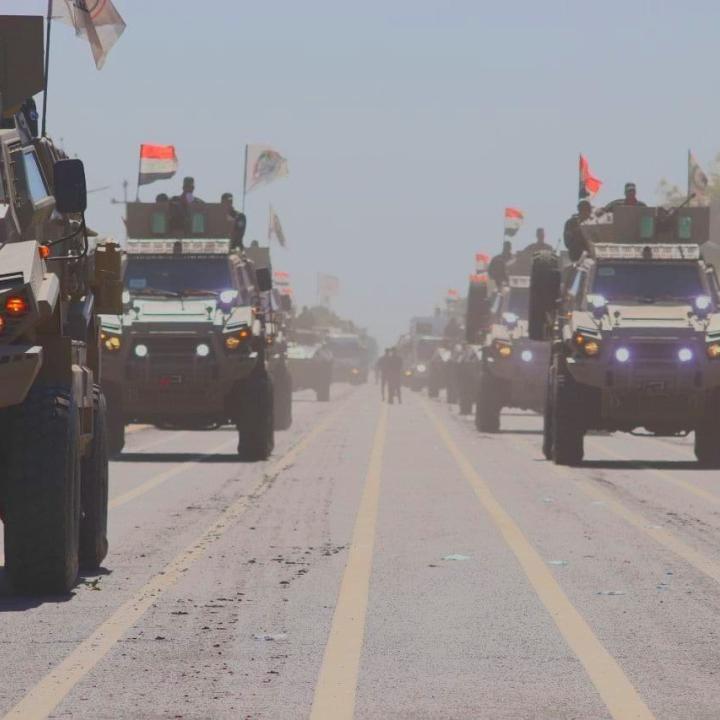
Militias Parade Under the PMF Banner (Part 2): Ground Combat Systems

Tehran has bolstered the ground combat capabilities of its proxy militias within the PMF, though the equipment rarely sees combat employment.
On June 26, the Iraqi Popular Mobilization Forces (PMF) undertook their most significant military parade so far at Camp Ashraf, Diyala. Attended by militias operating partially within the PMF rubric (e.g., the Badr Organization, Kataib Hezbollah, and Asaib Ahl al-Haq), the parade showcased a range of Iranian-provided systems intended to make the PMF look like a fully fledged military, on par with or exceeding the capabilities of Iraq's army, counterterrorism, and federal police forces. Part 1 of this blog entry covered drone systems featured in the parade; Part 2 covers Iranian-provided ground combat systems.
Seraj Satellite Datalink Mobile Stations
These stations are used in border and area surveillance networks comprising global system for mobile (GSM) communications nodes (Figure 1) and command-and-control vehicles. A similar network has been implemented on Iran's eastern and western borders under the name Shahid Kaveh. At least ten Seraj vehicles were sighted at the parade.
Sadad Electro-Optical Systems
Also present were several types of the Iranian vehicle-mounted Sadad (Stopper) family of electro-optical surveillance systems (Figure 2), including the Sadad-103 and -202 models, some of which were equipped with the RU-1000 day/night cooled thermal camera widely used by Iran's Islamic Revolutionary Guard Corps (IRGC) together with its low-altitude air defense systems. Those optical systems are marketed as being able to detect humans from as far away as 10 km and vehicles from over 20 km during the day or night.
MRAP Fleet
Large numbers of Toofan mine-resistant ambush-protected (MRAP) vehicles participated in the parade as well (Figure 3). These were made by Iran’s Shahid Kolahdouz Industries and deployed to the PMF between 2018 and 2020. They are a copy of a copy, modifying the Russian version (with KAMAZ V8 turbo diesel engines) of the Typhoon GS-300, a model originally made by the UAE-based Canadian multinational STREIT Group. At least 14 Toofans were shown, but the vehicle is rarely seen in PMF frontline operations, so it is unclear how many are in service.
Tracked Rocket Artillery
The PMF appear to have modified the old SA-6 (2K12 Kub) surface-to-air missile transporter-launcher to serve as a rocket launcher capable of transporting and firing large-caliber (333-366 mm) rockets, possibly including variants of the infamous Burkan (Volcano) fuel air explosive rocket. It is similar in configuration to the Syrian Army’s Golan-1000 multiple rocket launcher. Only one example was shown (Figure 4).
The parade also revealed new Raad-24 (Figure 5) and Raad-36 (Figure 6) 122 mm multiple rocket launchers. The former were mounted on an Iranian-assembled IVECO light truck; the latter were mounted on a M.A.N 6x6 truck produced under the license of Germany’s Rheinmetall near Tehran by Fath Industries, a firm affiliated with the Iranian Defense Ministry.
Main Battle Tank Modernization
The PMF also showed at least six (and probably as many as twelve) up-armored T-72 main battle tanks carrying Iranian explosive-reactive armor arrays. These upgrades were likely undertaken by the IRGC Ground Forces’ Shahid Zein al-Dinn tank overhaul and rebuilding center south of Isfahan and the Defense Ministry's Bani Hashem Tank Factory near Dorud in western Iran.
Analysis
As with the drones shown at the Ashraf parade, the PMF sought to project strength with the ground systems put on display, but the number of systems actually available for operational use is unknown. The PMF may be capable of fielding one or more platoons of tanks with survivability upgrades, and multiple company- and battery-strength units with conventional warfighting equipment. More interesting is Iran's effort to equip some PMF units with surveillance and protected mobility, which are more useful capabilities for PMF units engaging in counterinsurgency and border control. Static Iranian camera systems are clearly in operation across numerous PMF units, though Seraj, Sadad, and MRAP systems are rarely seen and may be showcase capabilities rather than widely provided and fielded systems. The deployment of such systems tends to reveal closeness with the IRGC; indeed, the Badr Organization controls the PMF's conventional heavy units (armor and artillery), while Kataib Hezbollah controls most intelligence and drone systems.













